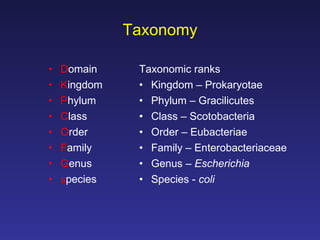Classification+structure+function
- 1. Classification, Structure and Functions of Bacteria Dr Kamran Afzal Asst Prof Microbiology
- 2. I. Classification of Bacteria
- 3. Taxonomy Taxonomy Organizing, classifying and naming organisms into groups - according to specific criteria Formal system originated by Carl von Linné (1701-1778) Bergey’s manual of systemic bacteriology (1927, 1984 and 2001)
- 4. Taxonomy D omain K ingdom P hylum C lass O rder F amily G enus s pecies Taxonomic ranks Kingdom – Prokaryotae Phylum – Gracilicutes Class – Scotobacteria Order – Eubacteriae Family – Enterobacteriaceae Genus – Escherichia Species - coli
- 5. Species and Subspecies Species Collection of bacterial cells which share an overall similar pattern of traits in contrast to other bacteria whose pattern differs significantly Strain A population of microbes descended from a single individual or pure culture (biovars, morphovars) Type Subspecies that can show differences in antigenic makeup (serotype or serovar), susceptibility to bacterial viruses (phage type)
- 6. Naming Micoorganisms Binomial (scientific) nomenclature Gives each microbe 2 components of its name Genus - noun, always capitalized species - adjective, lowercase Both italicized or underlined Staphylococcus aureus ( S. aureus ) Bacillus subtilis ( B. subtilis ) Escherichia coli ( E. coli )
- 7. Classification Systems Phylogenetic Classification System Groups reflect genetic similarity and evolutionary relatedness Phenetic Classification System Groups are based on convenient, observable characteristics – Morphology Cell shape and arrangement Colony morphology Cell wall structure (Gram staining)
- 8. Special cellular structures Microscopic morphology Biochemical characteristics Serological Tests Use group specific antiserum isolated from the plasma of animals that have been sensitized to the organism Chemical analysis Nutritional requirements Autotrophs, heterotrophs
- 9. Genetic and molecular analysis DNA composition G _ C , A _ T DNA analysis using genetic probes Nucleic acid hybridization Nucleic acid sequencing rRNA analysis Microarray
- 10. Major Groups of Disease Producing Bacteria Gram positive cocci Staphylococcus, Streptococcus, Enterococcus, Peptostreptococcus Gram negative cocci Neisseria gonorroae, Neisseria meningitidis Gram positive rods Corynebacterium, Listeria, Actinomyces, Nocardia Endospore-forming Gram positive rods Bacillus, Clostridium, Erysepelothrix
- 11. Gram negative rods – Facultative anaerobic Escherichia, Klebsiella, Proteus, Providencia Salmonella, Shigella, Yersinia, Vibrio, Haemophilus Gram negative rods - Aerobic/Microaerophilic Campylobacter, Helicobacter, Spirillium Bordetella, Brucella, Pseudomonas Gram negative rods - Anaerobic Bacteroides Fusobacterium
- 12. Spirochetes Treponema, Borrelia, Leptospira Cell wall deficient Bacteria Mycoplasma, Ureaplasma Acid fast bacteria Mycobacteria
- 13. II. Structure of Bacteria
- 14. Typical shapes of bacteria Most bacteria retain a particular shape; a few are pleomorphic
- 16. General properties of bacteria Non-membrane bound organelles More complex than viruses but less than living, cellular organisms Ribosomes smaller Inherited information held in single circular chromosome Bacteria range in size 0.3 to 14 micron Variable oxygen requirement Possess cell wall and an outer membrane in Gram -ve Can be grown in the lab given proper nutrition and oxygen in culture media
- 18. Capsule Protection Dehydration Immune mechanisms Glycocalyx - polysaccharide, protein Capsule if organized Slime layer if not Contributes to virulence
- 19. Cell wall Survival dependent on integrity of cell wall Role in cell division Chemical composition - Unique to bacteria Peptidoglycan - Main structural component Strengthening components Teichoeic acid Lipid A – endotoxin Mycolic acid - AFB Significance of Gram-positive vs Gram-negative Antibiotic sensitivity Sensitivity to lysozyme Sensitivity to alcohol
- 21. Gram-positive Peptidoglycan is a thick layer external to the cell membrane Gram-negative Peptidoglycan is thin and covered by an outer membrane (OM)
- 23. Teichoic acids Gram +ve only Glycerol, Phosphates and Ribitol Attachment for Phages
- 24. Cell membrane Phospholipid bilayer Carrier proteins - Porins allow molecules to pass through outer membrane Generally require energy to move against the concentration gradient Outer membrane is made of lipopolysaccharide (LPS)
- 28. Lipopolysaccharide (LPS) G -ve bacteria only Structure Lipid A Polysaccharide Functions Endotoxin: Toxic; kills mice, pigs, humans G- septicemia; death due to LPS Pyrogen: causes fever Adjuvant: stimulates immunity Heat resistant: hard to remove
- 29. Appearance of Colonies Mucoid: Smooth (lots of LPS or capsule) Dry: Rough (little LPS or capsule) O Antigen of Salmonella and E. coli 2,000 different O Ags of Salmonella 100’s different O Ags of E. coli E. coli O157 O Antigens differ in Sugars, not Lipid A
- 31. Flagella Movement Bacteria vary in the way flagella are attached Running, tumbling, swarming Can move toward or away from light or chemical stimuli Flagellin protein is unique to prokaryotes Arrangement Monotrichous; 1 flagella Lophotrichous; tuft at one end Amphitrichous; both ends Peritrichous; all around bacteria
- 33. Fimbriae and Pili Adhesion Fimbriae Conjugation Pili
- 35. 80% Water + 20% Salts-Proteins Nucleoid with single, circular, supercoiled DNA molecule No organelles (Mitochondria, Golgi, etc.) Ribosomes - Involved in protein synthesis Many bacteria have plasmids Small, extra-chromosomal, circular piece of DNA Genes present may not be required but may be advantageous (antibiotic resistance, resistance to metals) Cytoplasm and Internal components
- 36. Endospores Resistant structure Heat, irradiation, cold Boiling >1 hr still viable Takes time and energy to make spores Location important in classification Central, Sub-terminal, Terminal Bacillus stearothermophilus spores Used for quality control of heat sterilization equipment Bacillus anthracis spores Used in biological warfare
- 37. Endospores
- 39. Cell wall Which are more sensitive to Penicillin? Gram +ve Gram -ve Alcohol/Acetone affects which more? Gram +ve Gram -ve
- 40. III. Functions of Bacteria
- 41. Decompose organic waste Produce industrial chemicals such as ethyl alcohol and acetone Produce products used in manufacturing (e.g., cellulase) and treatment (e.g., insulin) Produce fermented foods such as vinegar, cheese, yogurt, butter, pickles and bread - Anaerobes
- 42. Used to produce antibiotics to kill other bacteria Streptomycin Erythromycin Chloromycetin Kanamycin
- 43. Recycling of nutrients Cyanobacteria Replenish supply of oxygen in atmosphere Autotrophic bacteria Convert carbon dioxide in the air to the organic compounds that are passed to consumers in food chains and webs A lot of bacteria are normal flora (commensals) of humans A few are pathogenic - disease-causing











































